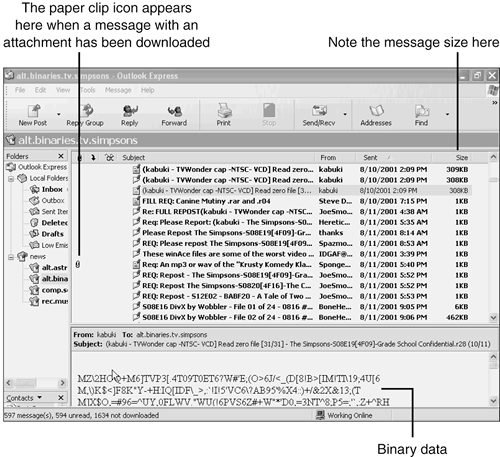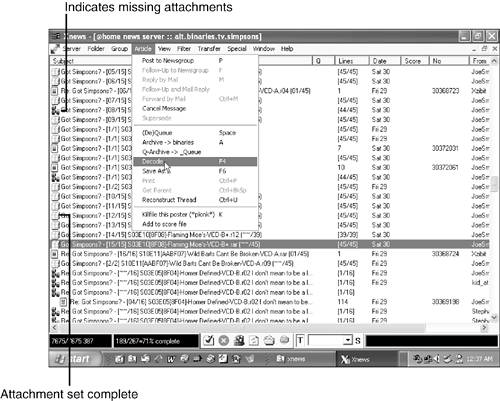Tips from the Windows Pros: Newsgroupsfor More than Just News
Tips from the Windows Pros: Newsgroups…for More than Just NewsNewsgroups began innocently enough as forums for university, government, and science research folks to find and offer various kinds of support and share info over the precursor to the Net. However, it didn't take long for Usenet to explode as a means of online recreation. Today, no matter how obscure you think your hobby or personal interest may be, a newsgroup is probably already dedicated to it. And one of the great advantages of newsgroups is the fact that files can be easily attached to posts. Attachments can be in the form of pictures, sound files, movies, text documents, programs, or anything else imaginable. In this respect, newsgroups really shine when compared to mailing lists; most mailing lists strictly forbid attachments, but in Usenet they are welcome. Newsgroups with the word binaries in their address are good places to find attachments. The word Binary refers to a non-text attachment, some kind of a data or program file. Naturally, you need to exercise some care before you download any messages with large attachments. First, ask yourself whether you have enough bandwidth to download the message. The OE6 message list doesn't show a paper clip icon until you've downloaded a message with an attachment, but it does tell you the size of each individual message, as shown in Figure 11.14. It is a fair assumption that a large file size would indicate the presence of an attachment. Figure 11.14. This newsgroup contains several messages that might contain large attachments. After you have determined that you can handle the message download, you should also keep virus safety in mind. If the attachment is a standard multimedia format, such as JPEG, WAV, GIF, MP3, or AVI, it should be safe. But if the attachment is an unknown format or is an executable program (.EXE and .VBS are common extensions for these), you should follow your standard anti-virus procedures. Large news attachments are posted as multi-part files, to get around the message-size limitations of news servers. These postings break up the large attachment over several consecutive posts. You can usually identify these types of posts by the Subject field, which identifies the message as part of a series. For example, you might see something like, "xfiles.avi (1/3), xfiles.avi (2/3)…," and so on. Multi-part attachments only open properly if downloaded and then combined together. Your first step is to identify each part of the series; if you miss even one portion of the series, it will not open properly. Use Ctrl+click and/or Shift+click to select each member of the series. After you've selected all of them, right-click the series, and choose Combine and Decode from the shortcut menu, as shown in Figure 11.15. Figure 11.15. You must be sure you select every member of a multipart attachment series before attempting the download. You are next presented with a dialog box asking you to put the series members in order. They should be in numeric order, starting with part one at the top of the list. Use the Move Up and Move Down buttons to place them in the correct order. Depending on the size of the multipart attachment, the download may take some time. When it is complete, a message window opens with a single attachment listed. This doesn't make much sense, since it looks as though you're going to send the file to someone. But typically you want to save it to your hard disk. So just right-click on that file icon in the attachment line, and choose Save As. Then save the file with the name and location you wish. Multimedia attachments in Usenet can be a lot of fun. For example, the group alt.binaries.tv.simpsons usually contains WAV and AVI files of popular sound bites and catchphrasesor even an entire episodefrom the television series The Simpsons. If you save downloaded WAV files in the \WINNT\Media folder of your hard drive, you can later assign those sounds to various Windows events. Wouldn't Windows be more enjoyable if each critical stop were accompanied by Bart Simpson's "Aye Carumba" rather than the monotonous Chord.wav? Another gem to be on the lookout for in Usenet is MP3 music. MP3 files offer CD-quality music, but because they use about one-twelfth the storage space, they can be transported efficiently over the Internet. You probably know about MP3s from all the hoopla about MP3 players such as the iPod and the old Napster court case, but you may not have known that MP3s were also available over newsgroups. Look for any newsgroup with mp3 in the address, but watch out for those bootlegs! If you become a serious newsgroup junkie, especially if you're into downloading (or uploading) large files, you'll have some boning up to do:
Figure 11.16 shows an example of Xnews. Figure 11.16. Xnews makes downloading, combining, and decoding multi-part news messages far less laborious than OE does. NOTE Some news readers, such as Agent-MP3, are specifically made to search Usenet and quickly find all the MP3 files. Notice how the icons on the left indicate whether all the portions of a message are on the server. If the block icon is full, all the pieces of an attachment are present, and you can begin downloading. If not, skip it, and try to find it on another news server, or ask the poster to repost that portion. This saves you from having to visually examine and count to be sure all the attachments are there. Also, assuming the postings are named correctly, Xnews doesn't require you to rearrange them before downloading and decoding. It does so automagically. |
EAN: 2147483647
Pages: 450